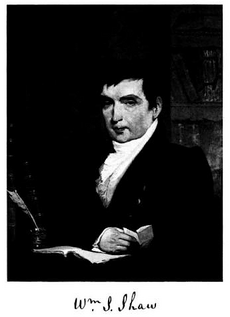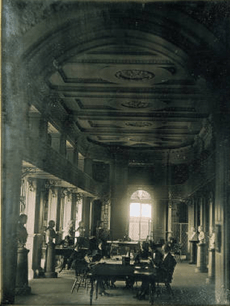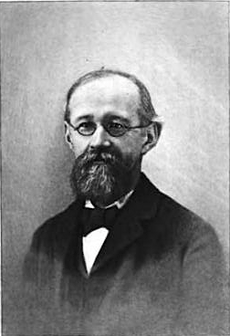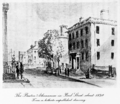Boston Athenæum facts for kids
Quick facts for kids Boston Athenæum |
|
|---|---|
| Country | United States |
| Type | Private |
| Established | 1807 |
| Location | Boston, Massachusetts, U.S. |
| Coordinates | 42°21′28.96″N 71°3′43.77″W / 42.3580444°N 71.0621583°W |
| Branches | 1 |
| Collection | |
| Size | 500,000+ |
| Access and use | |
| Circulation | 17,725 (FY 2016) |
| Population served | 4,345 (Membership, 2016) |
| Other information | |
| Director | Leah Rosovsky |
| Staff | 67 |
The Boston Athenæum is one of the oldest independent libraries in the United States. It is also a special type of library where people pay a yearly fee to become members. This allows them to use the library's services. The library started in 1807. It was founded by a group called the Anthology Club from Boston, Massachusetts. You can find it at 10½ Beacon Street on Beacon Hill in Boston.
The Boston Athenæum has many cool things. It has a huge collection of books you can borrow. There's also a public art gallery. It holds a rare books collection with over 100,000 special books. Its art collection includes 100,000 paintings, sculptures, and photos. The library also has important research materials. This includes one of the best collections of original documents about the American Civil War. It also hosts public events like talks, readings, and concerts.
Some of its most amazing treasures include a large part of President George Washington's personal library. It also has busts (head and shoulder sculptures) of Washington, Benjamin Franklin, and Lafayette. These were once owned by Thomas Jefferson. You can also see a first edition of John James Audubon's The Birds of America. There's a 1799 set of Francisco Goya's Los caprichos prints. The library displays portraits by famous artists like Gilbert Stuart and John Singer Sargent. It also has one of the biggest collections of modern artists' books in the U.S.
Many famous writers, scholars, and politicians have been members of the Boston Athenæum. These include Ralph Waldo Emerson, Nathaniel Hawthorne, Louisa May Alcott, and John F. Kennedy.
Contents
History of the Athenæum
How the Athenæum Started
In 1803, a young man named Phineas Adams started a magazine. It was called The Monthly Anthology, or Magazine of Polite Literature. Adams left the area in 1804 because he didn't have enough money. However, printers Munroe & Francis convinced other young men to keep the magazine going. They changed its name to The Monthly Anthology and Boston Review. By 1805, these young men formed a group called the Anthology Society.
The Boston Athenæum was founded in 1807. It was started by members of the Anthology Society. They first planned to have a reading room. The first librarian, William Smith Shaw, and the new leaders had big plans. They wanted the Athenæum to be like the Athenæum and Lyceum in Liverpool, England. Their idea grew to include a library with books on all topics. They wanted books in English and other languages. They also planned for an art gallery, coin collections, and even a science lab.
Over the past 200 years, this big plan has changed a bit. For example, there is no chemistry lab today. But the library has stayed true to its main goal. This goal is shown in its seal, chosen in 1814. It says Literarum fructus dulces, which means "Sweet are the Fruits of Letters."
The first yearly memberships cost ten dollars. Only members could use the Athenæum's rooms. They were allowed to bring guests. At first, you couldn't take books home from the Athenæum. Even members had to read books inside the building.
The Boston Athenæum first rented rooms. In 1809, it bought a small house next to the King's Chapel Burying Ground. In 1822, it moved to a large house on Pearl Street. A lecture hall and art gallery were added there within four years.
In 1823, Shaw stopped being the librarian. The King's Chapel Library and the Boston Association of Ministers' library were moved to the Athenæum. In 1827, work began on a catalog to organize the books. That same year, the art gallery opened its first yearly exhibition. In 1830, the library started letting members check out books. Once it became a circulating library, members could check out up to four books at a time.
Moving to Beacon Street
By the early 1840s, Boston was growing fast. Pearl Street became a busy business area. Warehouses were built all around the Athenæum. The library's leaders decided to build a new home. They wanted to make it easier for people to visit. Land was bought on Beacon Street, looking over the Old Granary Burying Ground. The first stone of the new building was laid in 1847.
In 1849, the Athenæum opened at its current spot, 10½ Beacon Street. This was the first building designed just for the Boston Athenæum. The first floor held the sculpture gallery. The second floor was for the library. The third floor had the paintings gallery.
The architect was Edward Clarke Cabot. He was an artist whose design was chosen because it was clever. He built an arch over graves in the Granary Burial Ground. This allowed more space on all floors above the basement. The building's front, made of Patterson sandstone, was unique in Boston. It still is today.
The Boston Athenæum also included sculptures by John Frazee.
New Ways to Organize Books
Charles Ammi Cutter became the librarian in 1869. Before him, the work on the library's full catalog was slow. The Athenæum's exhibition area became available. This happened when the Museum of Fine Arts moved its collections to its own building. Cutter used this extra space. He spread out the collections and worked on the five-volume catalog. He created his own way to organize books. It was called Expansive Classification.
Later, the Cutter system became the base for the Library of Congress's way of organizing books. The parts of a book's call number that show the author's name are still called "Cutter numbers" today.
Starting the Museum of Fine Arts
Many leaders of the Boston Athenæum helped create a separate museum in Boston. From 1872 to 1876, Boston's Museum of Fine Arts showed its art in the Athenæum's gallery. This was while its new building was being built. After that, there were no more yearly art shows at the Athenæum. Shelves were put in, and the library spread to the first and third floors.
The Athenæum in Recent Times
From 1913 to 1914, the Boston Athenæum hired architects Bigelow and Wadsworth. They expanded the building. The fourth and fifth floors were set back. This was done so they wouldn't change the look of the building's front. This update made the building safer from fire. It also added more space. This included the beautiful fifth-floor reading room and the fourth-floor Trustees’ Room. At the same time, new shelves were added. These were part of a ten-story "Snead stack" system. It filled a half-circle space from the basement to the third floor.
The Boston Athenæum was named a National Historic Landmark in 1966. Between 1999 and 2002, the building had a big renovation. This updated its climate control system. It also created more space for books. New gallery space was added on the first floor.
In May 2020, Leah Rosovsky became the new director of the Athenæum.
Famous Portraits by Gilbert Stuart
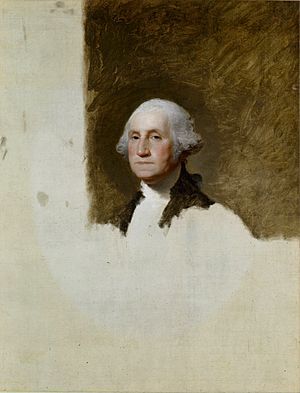
The Athenæum had owned two famous, unfinished portraits for a long time. These were of George Washington and Martha Washington. They had been on loan to the Boston Museum of Fine Art since 1876. But the Athenæum needed money. It asked the Museum to buy them, but the Museum said no.
Then, the Athenæum agreed to sell the portraits to the National Portrait Gallery in Washington, D.C. The price was $5 million. When this plan became public in April 1979, many people in Boston were against it. But the National Portrait Gallery said the portraits were important to the whole country. They believed the paintings belonged in the Smithsonian.
A group of important people in Boston tried to raise $5 million to keep the portraits in Massachusetts. But they didn't raise enough money. The Athenæum refused to lower the $5 million price. They said it was already a big discount from what the paintings were worth.
The City of Boston sued to stop the sale. They named the Massachusetts Attorney General, Francis X. Bellotti, in the lawsuit. His office is in charge of public property in the state. This led Bellotti to say that the portraits could not be sold without his permission.
In early 1980, the National Portrait Gallery and the Boston Museum of Fine Arts agreed to buy the portraits together. The plan was for the paintings to spend three years at each museum, switching back and forth.
Well-Known Members
- Hannah Adams
- John Adams
- John Quincy Adams
- Louisa May Alcott
- Cyrus Alger
- Erastus Brigham Bigelow
- Nathaniel Bowditch
- Uriah Boyden
- Josiah Cooke Jr.
- Charles Ammi Cutter
- Ralph Waldo Emerson
- Margaret Fuller
- Samuel Griswold Goodrich
- Augustus Addison Gould
- Thaddeus Mason Harris
- Nathaniel Hawthorne
- Oliver Wendell Holmes Sr.
- Oliver Wendell Holmes Jr.
- John Jay Chapman
- John Fitzgerald Kennedy
- Edward M. Kennedy
- Amy Lowell
- Paul Moody
- Daniel Treadwell
- Francis Parkman
What the Athenæum Does
The Boston Athenæum's main goal is to help everyone who wants to learn. It does this by making its collections and spaces easy to use. This helps inspire people to think, talk, create, and find joy.
Library Collections
The Athenæum currently has over 600,000 books. Its collections are especially strong in Boston and New England history. They also focus on biographies, British and American literature, and fine arts. The rare and circulating books, maps, and old papers show the library's interests. It used to collect everything in the 19th century. Now, it focuses on humanities and its large art collection. This includes paintings, sculptures, prints, photos, and decorative arts. Over 260 special funds help the library. The oldest and largest fund was started by John Bromfield Jr. in 1845. These funds help add more than 3,000 new books each year.
Old Printed Catalogs
Before creating a card catalog in 1903, the Athenæum printed several catalogs of its books. These were in addition to catalogs for special collections, like the Washington Collection. Here are some of the general catalogs:
- 1810 Catalogue of the books in the Boston Athenaeum.
- 1827 Catalogue of books in the Boston Athenaeum : to which are added the by-laws of the institution, and a list of its proprietors and subscribers.
- 1830 Catalogue of books added to the Boston Athenaeum since the publication of the catalogue in January 1827.
- 1831 Catalogue of tracts, scientific and alphabetical index.
- 1834 Catalogue of books added to the Boston Athenaeum in 1830–1833.
- 1840 Catalogue of books added to the Boston Athenaeum, since the publication of the catalogue in January, 1827.
- 1849 Shelf Lists, 1849.
- 1863–1868 List of books added to the library of the Boston Athenaeum.
- 1868–1871 List of books added to the library of the Boston Athenaeum.
- 1877–1896 List of additions. Second Series. No. 1–354. September 1, 187 to March 2, 1896.
- 1874 Catalogue of the library of the Boston Athenaeum. 1807–1871.
The first catalog, from 1810, was put together by the Rev. Joseph McKean.
Digital Collections Online
The Athenæum has made many of its items available online. It continues to add more digital items. These online collections are described on the website. This makes them easier for researchers, students, members, and scholars to use.
Here are a few examples from the many digital collections:
- The Henry Schoolcraft Collection of Books in Native American Languages.
- The Confederate States of America Imprint Collection, which includes stamps and money.
- Art Deco Designs by Cartier.
- Rare bookbindings from George Washington's own library.
- Alice Mason Civil War Photography.
Since 2013, the Athenæum has shared its many lectures with more people. They do this through Vimeo, which is an online video platform.
Special Collections of Rare Items
Here are a few examples of the Athenæum's special collections:
- Parts of the personal libraries of Cardinal Cheverus, Henry Knox, and George Washington.
- The Groome Gypsy Collection.
- The Danforth Alchemy Collection.
- The Merrymount Press Collection.
These collections include many things that are not found anywhere else. For example, there are newspapers from the Confederate States of America Imprint Collection.
Images for kids
More to Explore


